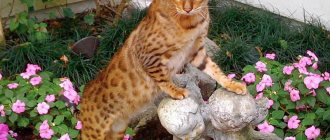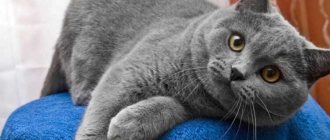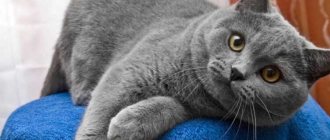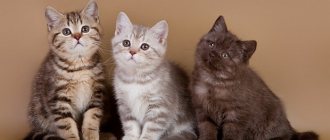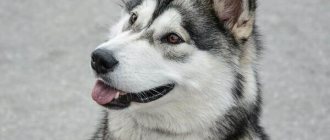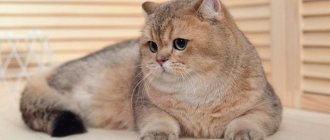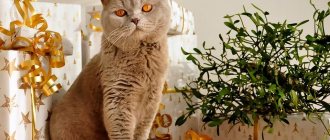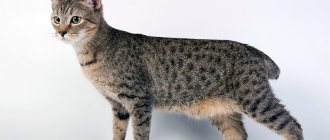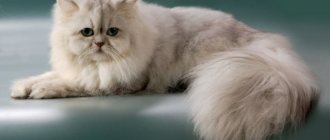Description of the Bengal cat breed
Popularity 5th place among 87 cat breeds
Lifespan:
12-15 years
Height:
40 cm
Country of origin:
USA
Average price:
15-30 thousand rubles
Weight:
4-9 kg
Latest articles Cat health
Ataxia in cats: what it is, how it manifests itself and is treated 01/23/2022 151 0 0
Cat health
Leukemia, or viral leukemia in cats 01/23/2022 140 0 0
Sex differences
Bengal cats are noticeably different from cats. Females are smaller; the difference in weight can be up to 3–4 kg. They have more refined head features and a more delicate silhouette. Both males and females are athletic and muscular pets, and at the same time very graceful.
There are also some differences in character. Cats are more independent and secretive; they always find a secluded place and do not allow anyone there. Males are more tolerant than females and quickly find contact with strangers. At the same time, they are more militant and characteristic.
Both cats and Bengal cats are very cheerful, they love to hunt and play outdoor games. They have insight, are very devoted to their owner, and completely trust him. If you find the right approach to the Bengal, both females and males are easy to train and train.
Bengals love water treatments
Advantages and disadvantages
- Pros:
- sociability, contact and almost dog-like devotion;
- love for other animals and children;
- Easy to care for – many Bengals love to swim, unlike other breeds.
- Minuses:
- high cost - even the cheapest pet-class kitten costs a decent amount;
- Bengal cats are also not the cheapest breed to keep - they need premium food and a lot of toys;
- Hyperactivity in Bengal cats can be a problem if there is no activity appropriate for it in the home.
Interesting photo
Look how beautiful it is!
Amazing look
Predator in the jungle... well almost
Who told you that Bengals are wild?
Caring mother with her family
Photos with a person
Exhibition copy
Estimate the size and features of the cat
Key facts
The Bengal cat is a popular and expensive breed. These are beautiful, graceful animals, outwardly standing out among other cats with their rare color.
The description of the Bengal cat breed says that these animals love games, walks, and move a lot. They have a sharp mind and can even be trained, so representatives of this breed can be seen among participants in cat agility. Bengal cats are suitable for equally active and experienced cat owners.
The Bengal distinguishes its owner from other people and quickly and easily gets used to the family. He is not aggressive, unpretentious and loves children.
A pleasant characteristic of the Bengal cat: representatives of this breed are clean and, unlike other cats, love to splash in the water.
Bengals are regular participants and stars of exhibitions, favorites of experts and breeders. They are regularly included in the top of various ratings of the best and most beautiful cats.
The owner of a Bengal cat becomes the owner of a pet leopard, which has the grace and beauty of large feline predators, but at the same time is completely safe for living together.
The final advantage is the high life expectancy of the Bengal cat: this large pet can live in good health for 15 years.
What are the dimensions and weight of Bengals?
The Bengal cat has quite impressive dimensions: at the withers, an adult cat of 1.5-2 years is approximately 40-41 cm. At the same time, a cat usually weighs 3.5-5.5 kg, and a cat - 5-8 kg. However, when purchasing a Bengal pet, you need to know that in some cases there are cats of both sexes both larger and smaller than the established values. But even if your Bengal cat suddenly turns out to be “too” large, this does not mean that obesity is to blame. Most likely, such a mass arose as a result of the pet’s well-developed muscles, because due to the characteristics of the breed, Bengals are very active and energetic animals, so they are definitely not in danger of being overweight. As for the length of the cat, it is usually about 90 cm.
History of the origin of the Bengal cat
The breed owes its existence in its current form to the American felinologist Jean Mill. Almost single-handedly, for many years she was engaged in the selection and improvement of Bengal cats.
It all started in 1961, when Jean, while in Bangkok, saw wild Bengal cat kittens for sale. Wild Bengals themselves were hunted and destroyed for the sake of a beautiful skin. Jean bought one kitten, named him Malaysia and brought him to the USA. Although the wild cat grew up at home, it was distrustful, non-communicative, preferred solitude, but did not show any aggression towards people.
At the call of nature, the grown-up cat accepted the courtship of the black domestic cat Jean. As a result of this union, a female kitten with the color of a wild Bengal cat was born, who received the nickname Kin-Kin. Kin-Kin had two kittens from inbreeding with her father, one of which died tragically, and the second did not inherit the color. Experiments to breed a hybrid were interrupted by Kin-Kin's death from pneumonia. Malaysia was sent to the zoo.
Breeding of the new breed resumed only 15 years later. Jean learned about scientific experiments in the laboratory of the University of California, as a result of which offspring were obtained from domestic and wild leopard cats. The leader of the experiment, Willard Centerwall, gave Jean Mill 9 females of the first hybrid generation. These cats became the founders of a new breed of domestic Bengal cats.
Until 1982, Jean bred cats with Burmese and Mau cats. In 1982, Jean acquired a wild golden kitten from a zoo in India and brought him to the United States. The kitten, named Delhi, was registered with the Cat Fanciers Association as an experimental Mau. In matings, Deli consistently passed on the shine of the coat to the offspring, which was established in a breed called glitter, and in 1983 Jean registered the first kitten of the new breed with TICA. But most of the cats of the first generations suffered from infertility, so Jean used wild Bengals for breeding.
A large number of Mau and Ocicat breeders reacted negatively to Mill's breeding activities due to reluctance to compete and inbreed with wild cats. As a result of such opposition, Bengals were not recognized for a long time by the association of cat lovers in the United States, although since 1985 they have been triumphantly presented at exhibitions, winning the hearts of visitors and experts.
Over the next 20 years, Jean Mill continued her breeding activities, introducing the blood of several more wild Bengals and creating several working lines of the breed.
Appearance description
Seeing Bengal, associations immediately arise with the jungle, mysterious thickets and their inhabitants. After all, this cat looks like a real leopard, only small. The fur of such a pet has a golden shine, a certain radiance, the so-called glitter, and dark spots form a bizarre pattern, like those of wild relatives.
Sweet couple
Bengals are short-haired cats. Their hair is very smooth, soft, and it is pleasant to stroke these cats. Pets are medium in size, muscular and well built.
They have strong paws, an athletic body, alert ears and an attentive, confident look. The facial expression of Bengal cats radiates confidence. The neat features are combined with a strong chin, large eyes and long vibrissae (sensitive hairs).
Representatives of the breed always attract attention - they are formidable predators in appearance, but affectionate social favorites in character. Bengals' movements are precise and dexterous, but sometimes these pets can fool around and therefore appear clumsy.
The calling card of these cats is the tabby color (spotted with small stripes, generally forming a beautiful pattern on the body), which has various variations. Typically, these cats have black or brown spots on a golden background ranging from light to deep red tones. However, there are also cool shades of hair.
If you like this breed, you can visit the International Cat Show Spring 2022 in Perm.
Similar cat breeds
Abyssinian cat
Egyptian Mau
Oriental cat
Differences from similar breeds
There are a number of spotted cats, the colors of which are similar to each other. However, this does not mean that all breeds are related. In addition to common features, representatives of such breeds have a number of differences and features. Let's try to compare them.
Egyptian Mau
These small graceful cats differ from Bengals in a more delicate physique, their muzzles are more pointed, and there are small folds of skin on the stomach, whereas lean Bengals do not have them. The color of the Egyptian Mau has fewer variations than that of Bengal cats; the spots are smaller, rounded, and can form stripes.
Egyptian Mau is an ancient breed, much older than Bengals. Despite the spotted coat, it is very difficult to confuse representatives of these breeds.
Ocicat
When breeding Ocicats and Bengals, Siamese cats were used, but the other breeds used were different. Externally, cats of the Ocicat breed are very similar to Bengals: the same rounded features, golden tone of fur with beautiful dark spots. But they are smaller in size than Bengals, the ears of Ocicats are sharper, and the whiskers are thinner.
Serengetti
Serengetti
The breed comes from Bengals and Orientals. These cats are somewhat more refined than their ancestors of the Bengal breed, they have a darker color with small spots.
The facial features are noticeably different - the Serengetti's ears are larger, the eyes have a narrower slant, the chin is not as powerful, the cheekbones are sharper.
Savannah
The history of Savannah is different from the Bengals. These cats appeared by chance when a domestic cat was crossed with a wild Serval. Established representatives of the breed have a spotted color - small black markings on a red background. Savannah's muzzle is very graceful - unlike Bengals, cats of this breed have a thin, sharp chin, a wide forehead, a large nose and large, pointed ears.
Savannah cats are large in size, maybe even larger than Bengals. The silhouette is also different - the limbs are thinner, while the body is strong and muscular.
Pixiebob
This is an original breed, different in appearance from Bengals. The main difference is that Pixie Bob's tail is very short. These cats grow from medium to large sizes, have a strong build, powerful paws and a large head.
The color is also different from the Bengal coat color. Pixiebobs have a different basic tone, the spots are small, dark, arranged to form a pattern on the sides and back of the cat.
Abyssinian
First of all, they differ in size. The Bengal cat is significantly heavier than the miniature Abyssinian, and both cats and cats. Bengals are tame and more playful. If you need constant contact with your pet, then it is better to pay attention to them.
The colors also differ. The Abyssinian cat, as a rule, does not have pronounced spots. The color is distributed more evenly throughout the coat. In addition, there may be a complete absence of any stains.
Each of these breeds is individual, has its own interesting history of origin and different characters. But they all make wonderful pets.
What does a Bengal cat look like?
Despite their large size, cats and cats look very elegant. They are characterized by true feline grace, and the skin stands out due to its special shine and color character. In the photo, the Bengal cat is not as beautiful as in life, because the photo cannot convey its luxury.
Muzzle
The head of a Bengal cat is wedge-shaped with smoothed corners. The back of the head is smoothly continued by the neck, and the size of the skull is medium-sized, in good harmony with the general appearance of the animal. The profile according to the American standard should be straight from the brow ridges, and according to the European standard the transition from the forehead to the nose may stand out a little.
The nose itself is quite large and is in line with the chin. The jaws are well developed; in adult cats, the cheeks stand out. The ears are relatively small, fit harmoniously into the lines of the skull and, unlike most other breeds, have rounded rather than sharp tips.
Bengals' eyes are almost round and very expressive. Their color depends on the color of the animal and can range from light green to golden and from pale blue to aquamarine.
Body type
What does a Bengal cat look like? The body is muscular, with strong bones and a well-developed chest. The Bengal cat is graceful, rectangular in size, but not of the oriental type. It is not as large as the Maine Coon, but is larger than most modern breeds. Weight reaches 9 kg, height - up to 32 cm at the withers, and length with tail can reach a meter.
The photo clearly shows that males are much larger. Despite the fact that Bengals grow up to 24 months, the main growth ends at 9 months. The limbs are muscular and go well with the overall appearance of the Bengal, and the tail is thick, of medium length with a rounded tip.
Coat and color
The color of the Bengal cat makes it stand out from others; the main breeding was carried out on it. It should be contrasting, although kittens have such a wild heritage as phasing - at 3-4 weeks the skin of a purebred kitten turns pale, and again becomes contrasting after a couple of months. The pattern itself can be marbled or spotted, but, in any case, the spots should be clearly defined.
There should be no white spots. The Bengal's coat should be short and close to the body. Wool of medium or longer length is considered a significant fault. Now there are 6 varieties of Bengal cats by color:
- brown tabby;
- silver tabby;
- seal sepia tabby;
- seal mink tabby;
- blue tabby;
- seal links point.
All cats of the breed must have the effect of shining fur - that same glitter.
Coat color
Thanks to its wild color, the Bengal cat has gained worldwide fame. A large list of colors is officially recognized, which is presented in the photo. The main requirement for fur is maximum contrast between the background and the pattern. The paws and tail are always distinguished by a pattern in the form of stripes rather than spots.
Interesting!
Kittens may be born light colored. As you get older, a pattern will emerge. The kitten's final Bengal color appears at 8 months.
By pattern type
The color of Bengal cats is not only multi-colored, but also has different patterns. There are several dominant colors: leopard, spotted and marbled.
Leopard (Rose)
These are the most common colors. Already from the name it is clear that this is a pattern consisting of beautiful spots of “rosettes”. The outline of the rosette is highlighted in black or dark brown. The core is darker than the main fur, but lighter than the outline. The socket can have a closed or open circuit.
Spotted (Spot)
The description of the spotted pattern is quite simple - these are monochromatic spots of dark color located throughout the fur. They should be very bright and contrasting. Usually their size is slightly smaller than that of a socket. There are different types of stains. Most likely they will be round, but there are also oval, elongated spots.
Marble (Marble)
The marble color is much less common than leopard and spotted patterns. The stripes are located along the fur coat, and not across, like the usual stripes of the British. The Bengal marbled cat has spots of various shapes. The main condition is their clear outline. The marbled cat looks more like a tiger cub than a leopard.
By coat shade
The color of Bengal cats is divided into 5 main shades of fur. The golden shade is considered classic. In addition to it, there are silver, snow, blue and charcoal colors.
Golden (Brown)
The main color of the coat varies from golden yellow to light brown. The spots are highlighted in dark brown or black. The eye color is green or golden. The tip of the tail is always marked black.
Silver
The background fur is white, gray or silver, steel. The tip of the tail is also marked with a black spot. The markings on the fur are gray with a black outline. The eye color is green or golden.
Snow
Snow color is further divided into snow lynx, mink, sepia - from lightest to darker. In general, the snow cat has a light fur color - cream or ivory. Sometimes the fur is almost white. The marks can be light, as if faded, or more pronounced - beige, dark brown. Eyes can be blue, green, green-blue, golden.
Snowy colors are valued by breeders. Less often it can be found in combination with a marble pattern.
Blue
The fur is gray with a blue tint. These types of colors are not found very often. The main thing in describing this color is the cold undertone of the coat. The spots are gray-blue or dark gray. The iris color is green, brown or golden. The end of the tail is highlighted in dark grey.
Coal
The main color of the fur is charcoal, dark gray or brown. The Bengal cat in the photo is a perfect example. This photo shows fur with a cool undertone. The spots are highlighted in an even darker shade. Outwardly, it looks like the cat really got dirty in something charcoal-dark. The muzzle has a patterned mask with white circles around the eyes. Eye color is green, golden or brown.
Bengal cat personality
Despite their close wild roots, Bengals are devoid of aggressiveness, very sociable and friendly with proper socialization. The character of the Bengal cat is partly “canine”; it needs people and communication much more strongly than most representatives of the cat family.
This breed loves children and all family members. They get along well with other animals, including dogs. But due to their highly developed hunting instinct, it is not recommended to keep them together with birds, rodents and even fish, since Bengals love to swim. You shouldn't be surprised if you find your pet in the bath you've drawn for yourself.
The Bengal cat, despite all its sociality, does not like to be cuddled when it is not in the mood. But if the Bengal is tuned to tactile contact, you won’t get rid of it so easily! They also love to talk. Their meow is rich in nuances, and an attentive Bengal owner can understand it quite well.
The Bengal cat's main personality trait (and flaw for some) is hyperactivity. Both the kitten and the adult cat are ready to run around day and night. A bored and unoccupied Bengal can cause a lot of trouble at home, so this breed should have a lot of toys that keep them well entertained, and tall, branched cat “towns.”
Who is the Bengal cat suitable for? Families with children, dogs, other cats, active young families without children, breed lovers who are ready to work with animals.
Character and behavior
These seemingly wild cats are completely domestic in nature. However, they have a zest and excitement that makes them look like real little jaguars. Bengal cats become attached to their owner and open up to him. Some pets can be short-tempered and become tense when someone tries to enter their personal space. But Bengal will always treat his beloved owner with confidence and remain loyal.
Warning! Representatives of this breed have a very developed hunting instinct, so they should not be left alone with poultry and rodents. Bengal could become a threat to them.
If a cat has access to the street, it will almost certainly hunt mice, lizards and other animals that are attractive to it, although it is unlikely to eat the prey.
Bengals are natural leaders. They gather all the pets around them, if there are any in the house, always becoming the center of attention and setting the atmosphere. These cats are gentle, love and appreciate affection. However, they may not allow themselves to be touched if they are not in a good mood.
Representatives of the breed need their own personal space, as they have a certain need to sometimes retire. It’s better to immediately buy your pet a special house or at least a carrying bag. You cannot force yourself on these cats, however, given their strong character, you also cannot indulge them. You need to find that golden mean when you can combine patronage, education and respect. Bengals have a subtle mind, so finding a common language with your pet will not be difficult at all.
Does it really look like a leopard?
Bengals treat new people differently. They can be distrustful or, on the contrary, take the initiative and be the first to get acquainted with interest. Representatives of the breed never cease to amaze their owners.
These cats are naturally tolerant and funny, but sometimes they can get into a frenzy, succumbing to the hunting instinct, and behave unintentionally harshly in play.
Bengals are very stubborn and will never do anything they don't want to do. But usually this trait is not a problem, since representatives of the breed are sensitive and understanding, and they learn well.
Raising a Bengal cat
Bengal cats have a sharp mind and cunning. They easily adapt to any conditions. Their intelligence combined with high activity makes them suitable candidates for learning tricks and certain commands. Many cats of this breed participate in cat agility competitions. Physical methods of punishment are unacceptable, and they are not necessary - Bengals are sensitive to the intonation of the owner’s voice.
The Bengal's intelligence and ability to analyze allow him to learn how to open cabinets, doors to rooms, turn on faucets and do other repetitive tasks at home.
Many potential owners, due to the presence of wild cat genes, are wondering how to toilet train a Bengal and how easy it is. Don't worry: Bengals quickly understand where to relieve themselves. Sometimes, if the kitten has chosen a place for himself, it is enough to put a tray there.
There should be a lot of filler in the tray, as representatives of this breed dig deep holes. Clean Bengals' toilets need to be cleaned on time. If you follow these simple rules, there will be no problems with training.
Looking for a Bengal cat? Find your pet from 3 offers Buy as a gift
Reviews
I reviewed the reviews from the Otzovik website and chose the most interesting statements about the breed.
Smart and resourceful
The author draws attention to the fact that the cat is very friendly and adapts to the owner’s character. Separately notes the ingenuity and activity of the pet. Of course, I would like to praise the owner: she reacts with humor to all manifestations of the cat’s thriftiness.
Peaceful and kind
The author of the following review begins by saying that her cat combines the tenderness of a domestic animal and the habits of a wild one. But this does not affect the relationship with the residents of the apartment - the pet is not aggressive towards people and its relatives. Separately, the author draws attention to the cat’s talkativeness and a certain willfulness.
Loud voice and gastrointestinal problems
The following review is interesting because the author confirms that the breed has some problems - weak intestines and the need to carefully choose food. Inside the review, the owner talks about the cat’s activity and excessively loud voice, especially if it’s time to eat.
Bengal cat health
Possible diseases
The health of the Bengal cat is good, in addition, they are long-lived. Until recently, their only problem was a tendency to problems with the gastrointestinal tract, which were solved by choosing the right food and a selected diet and diet. However, Bengals are not prone to allergies. But now breeders identify several quite serious congenital and hereditary diseases in the breed:
- flat chest syndrome;
- hypertrophic cardiomyopathy;
- polycystic kidney disease;
- leukemia and leukemia;
- thickening of the heart muscle.
All these diseases require careful monitoring by a veterinarian and timely adequate treatment.
Reproductive health
Female Bengal cats mature at about one year of age. Although heat may occur earlier, it is not recommended to breed a cat before one year of age. Males are usually ready to mate by 9 months.
Bengal cats have a regular cycle: most females go into heat four, and in rare cases, five times a year. The estrus itself lasts 8-11 days: in the first period (proestrus, about three days), the cat becomes very affectionate and behaves characteristically, but will not let the cat near. The second period (estrus) lasts about 8 days, during which time the female actively purrs, withdraws her tail, and tramples. Now she is ready to accept a cat, these 8 days are a suitable period for mating. Cats do not have bloody discharge during estrus, so if you notice it, then this is a reason to contact your veterinarian.
Mating takes place on the territory of the male, the female is brought to him for several days. Some animals get to know each other and take a closer look at each other, and some immediately mate. After successful mating, the cat becomes calm.
Pregnancy occurs easily in a cat, 90% of animals become pregnant on the first try, but this can only be confirmed by ultrasound after a couple of weeks. The pregnancy of a Bengal cat lasts 64 days, slight deviations, plus or minus, are possible.
Starting from the third week, the cat’s food is increased by 10%, and towards the end the cat eats less. If she refuses to feed, childbirth is close, and it’s time to think about organizing the birth and postpartum space. The Bengal needs a place that is closed on all sides with soft bedding. A house or just a box with a cut-out entrance would work well. It is better to put a disposable diaper inside.
Childbirth usually goes well; some problems are possible in primiparous cats. There are usually 2-4 babies in a litter; more numerous offspring are rare. Bengal cats are excellent, caring mothers. After giving birth, you should not disturb the mother and babies for several days.
Nevertheless, Bengals are quite difficult to breed by selecting a pair. This is a complex analysis and comparison of genes, advantages and disadvantages of ancestors and lines. Deficiencies must not be allowed to become established in the breed. Therefore, it is advisable that an experienced breeder be involved in the selection of a partner.
Individuals with serious breed defects should not be bred. Breeding with other breeds other than wild Asian cats is not allowed. Therefore, in order to avoid uncontrolled matings, many kittens are sold with the condition of sterilization or castration. These simple operations will relieve your cat of unsatisfied desire and the resulting behavioral problems. In addition, sterilization and castration eliminate the occurrence of cancer of the reproductive organs.
Hereditary diseases
In addition to infections, any cat is susceptible to genetic diseases. This problem has not escaped the Bengals either. There are several types of most common diseases.
Gastrointestinal problems
This is a problem of the first order. Bengals have a sensitive stomach and a shortened intestinal structure, characteristic of wild cats. They are susceptible to food poisoning. It is difficult for animals to choose food; it is rarely possible to do it the first time. Any new treat causes digestive problems and changes in stool.
Here, owners will have to be patient and give preference to holistic or premium food. It is better to coordinate the new menu with the veterinarian, informing the doctor about the pet’s problems.
Progressive retinal atrophy
The disease is painless for the cat and unnoticed by the owner. Gradually the retina of the eye dies, leading to complete blindness. It's not always clear why this happens. Usually the disease is diagnosed at the age of 5-6 months. It can be stopped early to avoid big problems. Nothing can be done about the chronic form.
The first symptoms are night blindness, avoidance of dark rooms, slow movements, lack of reaction to a change of environment (crashes into a new table or jumps onto a cabinet that no longer exists).
Hypertrophic cardiomyopathy
Cardiovascular disease can be congenital or acquired. This is a tendency to heart disease, which is provoked by one of the thickened walls of the myocardium. In the early stages, the disease is not diagnosed during a standard examination; there are no symptoms. If left untreated, it can cause sudden death.
For this reason, it is important to conduct an annual cardiac ultrasound and ECG to ensure that your pet does not get worse. With medication support and a calm lifestyle, the cat will live a long life.
Important!
These diseases are rare. Despite this, it is important to monitor the animal’s condition in order to prevent the development of a chronic form of the disease.
Features of feeding and diet
Bengal cats have delicate stomachs, so it is best to feed them a premium, balanced dry food. The change of food should be gradual, and dry food should not be mixed with natural food.
If the owner still wants to feed the cat natural food, then the bulk of the diet should be lean meat and offal. It is better to give sea fish and not very often - 1-2 times a week. In addition, the diet should include fermented milk products and some vegetables. Cats should not be given whole milk. It is better to cook for Bengals separately - you should not feed them from the common table. For natural breeding cats, vitamin complexes should be added to their food.
Bengal cats are fed 3-4 times a day, and water should be freely available. Bengals love to drink from special drinking fountains.
How and what to feed a Bengal
Feeding the offspring of a leopard cat is carried out in accordance with a special feeding schedule, as well as according to the instructions of specialists. If the nutrition is complete, the baby quickly turns into a strong and healthy cat. It is important that a Bengal's diet contains a sufficient amount of protein - this is especially true for large, active and neutered cats. One way or another, approximately 90% of the menu should consist of meat and fish, as well as offal, dairy products, including cottage cheese, vitamins, minerals and polyunsaturated types of acids. The Bengal kitty will not refuse raw rabbit meat and low-fat cream, as well as vegetables - tomatoes, carrots and so on. But it is better to replace raw offal with boiled sea fish.
Bengal cats are extremely susceptible to poor quality food, which is why your pet should receive only selected food and not stagnant water to avoid loose stools and health problems.
You can also switch your Bengal cat to dry food. True, the “rule of the highest quality” should also work here: it is desirable that the popular crispy “cookies” be not just premium, but super-premium.
Care and maintenance
Caring for and maintaining a Bengal cat does not cause any trouble, as these animals are unpretentious. They do not require haircuts or frequent combing. Their fur does not tangle. There are usually no problems with washing cats; on the contrary, you will have to make sure that the Bengal does not bathe too often.
Nails are trimmed a couple of times a month. Ears and eyes are cleaned as they become dirty. Sometimes you can brush your teeth with a special toothpaste or buy your cat special chewing treats.
A Bengal cat should have its own place where it can retire. Often cats ignore specially purchased houses and choose the most incredible places.
The cat's home must be safe. Pay special attention to house plants - some familiar and ordinary flowers can become real poison for an animal. Many cats love to chew greens, so to satisfy this desire, you can buy her special grass in the store, which will also be an additional source of vitamins.
It is necessary to take into account the active nature of the breed and provide it with a place where the cat can splash out its energy - a cat town, a playroom, etc.
If you live in an apartment, you should not keep windows and loggias open. Bengals are not at all afraid of the street, and a walk along the ledge can lead to tragedy. It is better to attach mesh to the windows. But the breed is suitable for walking on the street, although it is better to walk in the city on a leash and at the same time make sure that there are no aggressive dogs on the horizon.
Health, tendency to disease
This is a hardy breed with good health. The first Bengals only had problems with the gastrointestinal tract. Pets still often have intestinal disorders. But over time, other diseases began to appear in pets. These are hypertrophic cardiomyopathy (HCM) and flat chest syndrome (FCK) in kittens. Allergies are not that uncommon.
As for the weak immune system, it is characteristic of lines in which matings between close relatives were allowed more than once. Such individuals must be regularly vaccinated and dewormed.
Disease Prevention
- A well-chosen diet - the food must be fresh and of good quality.
- Annual examinations with a veterinarian - an experienced specialist will identify most dangerous diseases at an early stage.
- Vaccination - kittens are vaccinated in the nursery, then the new owner must adhere to the vaccination schedule against the most common feline diseases.
- Control of parasites – the Bengal needs to be protected from helminths, ticks and fleas.
- Sterilization – if animals are not involved in breeding, they must be sterilized. There is no other option. There is no such thing as “giving birth for health.”
Tips for choosing a kitten
The Bengal cat is a fairly expensive breed, so you shouldn’t chase a low price and buy a kitten secondhand, without documents, on dubious online bulletin boards or a bird market. It is best to contact a nursery or breeder with a good reputation. Only there you can find Bengal kittens that fully meet the standards.
What is important:
- a Bengal kitten must have documents: a pedigree indicating the generation, and a veterinary passport with the first vaccinations;
- a good breeder will not sell a kitten under two months old;
- a Bengal kitten at the age of sale weighs about a kilogram;
- the kitten should be active, playful, with clean eyes and ears, shiny shiny fur;
- he should not hiss and break out of his hands - a poorly socialized kitten will be wild and isolated;
If you are purchasing a kitten for exhibitions or, especially, breeding, pay attention to the absence of defects and defects.
Castration and sterilization
This procedure is necessary for Bengal cats whose breeding is not intended. Otherwise, semi-feral cats will begin to mark their territory, tear apart furniture and even become aggressive.
Early castration of males is carried out at the age of 3-3.5 months. Cats are sterilized at 5-6 months. In general, adult animals tolerate surgery well before the age of 2 years.
Important!
Spaying and neutering relieves the cat of the extreme stress that she experiences during the period of estrus, not being able to complete the reproductive cycle.
How much does a Bengal cat cost?
Purebred kittens with documents cost from 15,000, and the final cost can reach 150 thousand or more. The rarest and most expensive color is blue tabby; the price of a Bengal cat with this shade ranges around one hundred thousand.
The lowest price is for pet class pets. These are cats with defects in color and appearance; they are not allowed for exhibitions and breeding, and are usually sold for sterilization. The cost of such kittens varies from 15 to 30 thousand rubles.
Breed-class cats are already more expensive. They will not be show stars, but do not deviate from the standard and can be accepted for breeding. If the animal is sold with the condition of sterilization, then the price will be lower - 30-50 thousand rubles, and if with the possibility of breeding, then higher - 50-70 thousand.
The most expensive cats are show class. These representatives of the breed are purchased for exhibition career and breeding. Their cost starts from 60 thousand rubles for sterilization, and how much an animal with permission for breeding will cost depends only on the cat itself and the seller. Typically the starting price is 80 thousand.
Do you like the article? 0
How to choose a kitten, its cost
There are kittens of the early generation (basic Bengals F1). One of their parents is a wild leopard cat. The kittens retain the wild habits and distinct external characteristics of a wild leopard cat. In terms of size, they can be larger than ordinary cats. They are not suitable for exhibitions. Usually they like to buy them for breeding in order to improve the overall gene pool.
A more budget option is SBT-Bengalis. Their wild ancestor was in the fifth or more distant generation. The four previous generations of Bengal cats and cats consisted of purebred pedigree Bengals. Such kittens are more flexible, affectionate, and get used to being handled more easily. Outwardly, they are more reminiscent of domestic cats, but even here you should be prepared to show character.
Important!
The optimal generation characterizing a purebred Bengal is F4-F7. Sometimes kittens are reserved immediately after birth, because... This species bears 1-3 kittens.
The breeder must provide a pedigree, a vaccination passport, and may need the results of tests and studies confirming the health of the pet.
To choose a healthy kitten, you need to know the signs of a healthy animal:
- clear, open and interested look;
- lack of mucus in the corners of the eyes;
- smooth and beautiful fur, without bald spots or tangles;
- confident gait (if the baby is less than 3 months old, hesitant behavior is allowed);
- interest in guests, lack of aggression in the kitten and mother;
- the breeder must show the kitten’s mom and dad so that there is no doubt about the purebred of the breed;
- You should definitely meet the breeders and animals face to face.
Many people are interested in exactly how much a kitten costs. However, it is impossible to give a fixed price. The minimum cost of a kitten is 20-25 thousand rubles. The price can rise to 60-100 thousand rubles. If the animal has minor defects, it will cost less. If the pet is planned to be used for breeding, the price will be higher. The cost depends on the rarity of the color.
It is better to purchase females for breeding, and males for exhibition careers. Kittens are adopted no earlier than three months of age. At this point, they easily switch to solid food, are trained to the tray, and have the necessary vaccinations.
Important!
To buy a Bengal, it is better to find an official nursery where kittens are taught to be handled from birth. Cats cannot be kept in enclosures.
conclusions
Bengals are cats that are very loyal and loving to their owner. They are friendly with strangers, but only open up to close ones. These are restless, playful pets, they love to play, come up with fun and constantly require attention, so people who are seriously busy at work should not have them. These cats are not suitable for people who cannot devote enough time to raising Bengals, providing their pets with a nutritious, balanced diet, and those who love peace and quiet.
However, for those who know how to properly raise their four-legged friend, appreciate their characteristics and devote enough time to caring for their cat, the Bengal will become a truly wonderful ally and faithful companion.
